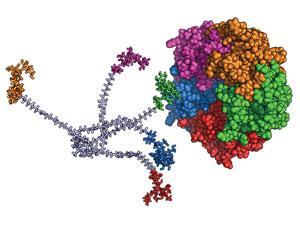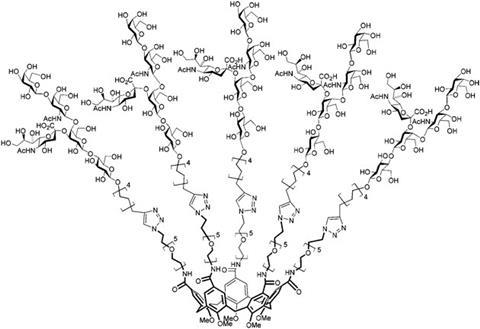
Cholera is an acute intestinal infection that can be fatal in severe cases. It is caused by the cholera toxin, a protein with a disease causing A subunit, surrounded by five B subunits. The B subunits bind to GM1, a pentasaccharide sugar, on the cell membrane of intestinal cells. Once attached, the cholera toxin can inject its toxic A subunit into the cell.
‘Optimally, one would bind all 5 B subunits to one inhibitor that uses this natural GM1 sugar,’ explains Han Zuilhof, from Wageningen University, the Netherlands, who led the work. ‘This should yield the strongest one-on-one complex. Previous work combined either pentavalent scaffolds with simpler sugars, or non-pentavalent scaffolds with the real deal sugar.’ Now, Zuilhof and colleagues have created the first inhibitor that is both pentavalent and uses GM1.
Anna Bernardi, an expert on the design and synthesis of glycomimetics at the University of Milan, Italy, is impressed by the complexity of the inhibitor. ‘They combined expertise on the efficient enzymatic synthesis of GM1 with expertise in calixarene chemistry, which allowed them to synthesise a difficult calix[5]arene scaffold.’ She adds that this could be a very important step for improving understanding on multivalent interactions.
Anne Imberty, a structural glycobiologist from CERMAV-CNRS, Grenoble, France, says the inhibitor is a perfect lure for the cholera toxin. ‘The pentameric scaffold presents oligosaccharides in exactly the same architecture as glycoconjugates on human cells. This inhibitor has two advantages – it has high affinity for the toxin, and it is soluble. Therefore it is an excellent competitor in comparison to glycans on human cells, and it can trap the toxin before it damages human tissue. The power of multivalency has been revealed.’

‘There is a wide realm of chemical biology that we are only starting to discover and synthetic chemistry will continue to play a crucial role in this area,’ concludes Zuilhof.






No comments yet